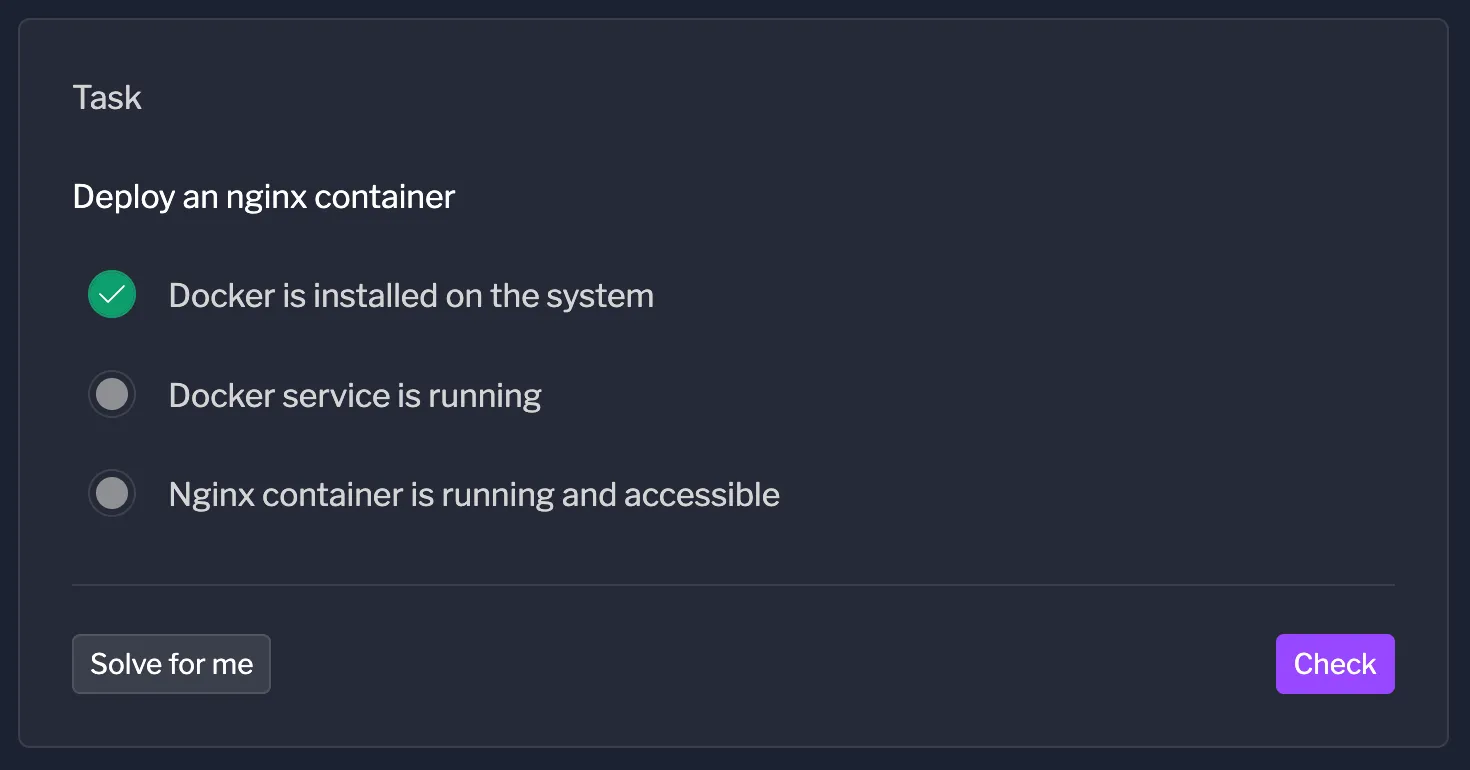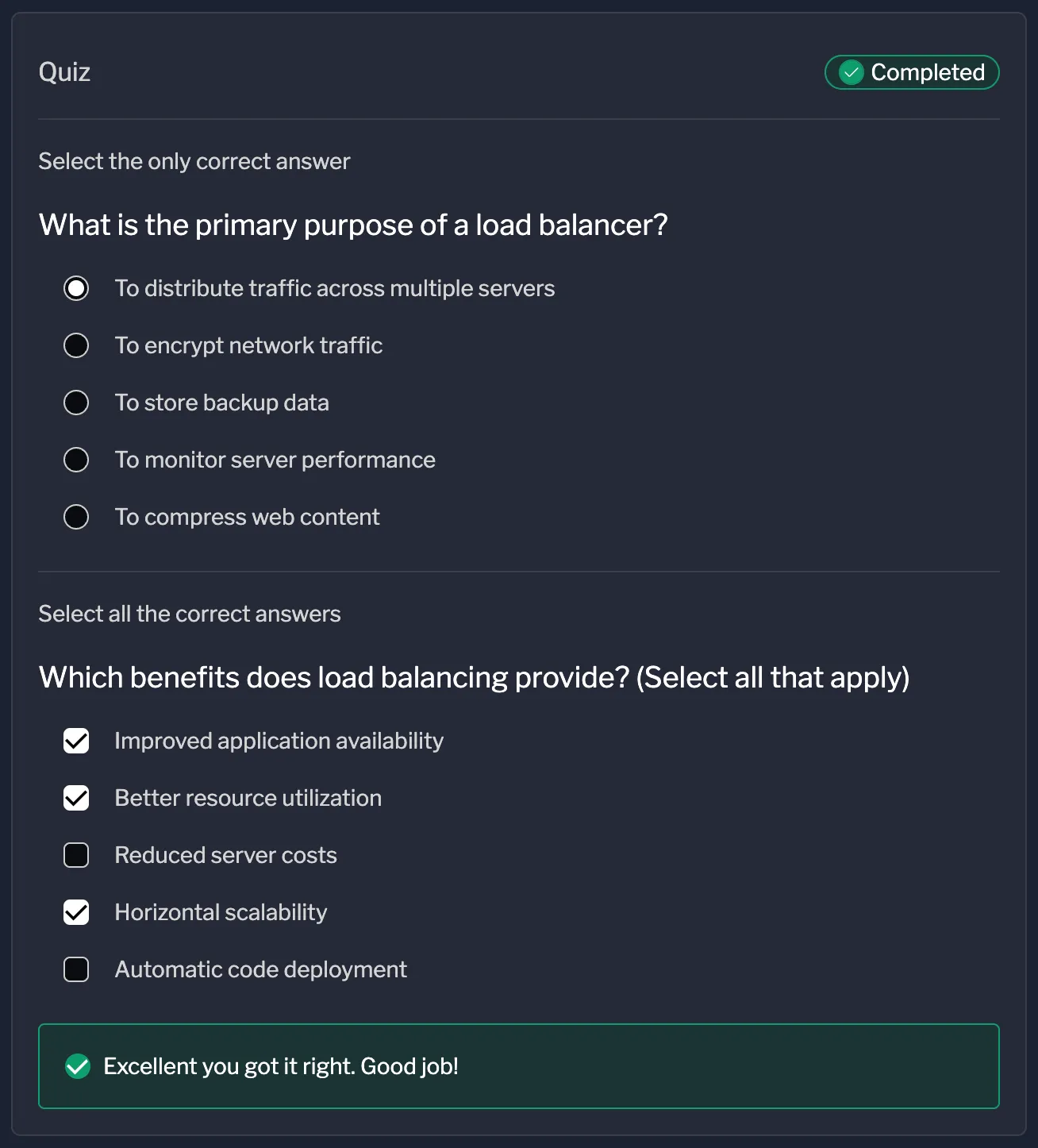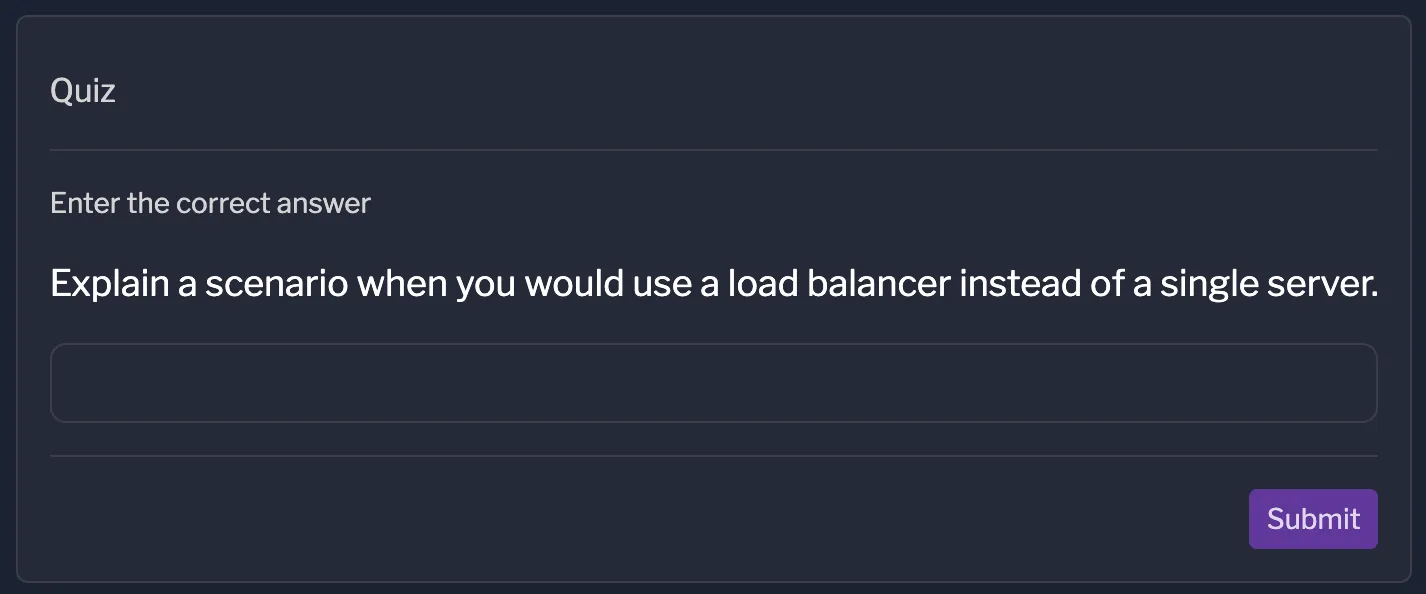Creating Activities
Overview
Section titled “Overview”Activities are interactive elements that transform passive reading into active learning. They’re what make your lab engaging - where users don’t just read about deploying applications or configuring databases, they actually do it. Instead of memorizing concepts, users practice real-world skills and receive immediate feedback on their work.
Think of activities as the bridge between theory and practice. When users read about container orchestration, that’s theory. When they deploy a multi-container application and get instant validation that it’s working correctly, that’s learning through doing.
Instruqt provides two types of activities:
- Tasks: Hands-on challenges with automated validation where users perform technical work in real environments
- Quizzes: Knowledge assessments that test conceptual understanding and reinforce learning
This page helps you understand what activities are, when to use each type, and how they transform your lab from a documentation page into an interactive learning experience.
Why Activities Matter
Section titled “Why Activities Matter”Traditional documentation asks users to read and remember. Activities ask users to do and experience. This fundamental shift changes how people learn. Let’s consider tasks:
Without Tasks (Passive Learning):
- Users read: “To deploy a container, run
docker run nginx” - They might understand the concept
- They don’t practice the skill
- Knowledge fades quickly
With Tasks (Active Learning):
- Users read the same instruction
- They actually run the command in a real environment
- Automated validation confirms they did it correctly
- They build muscle memory and confidence

The same goes for quizzes:
Without Quizzes (Passive Learning):
- Users read: “Load balancers distribute traffic across multiple servers”
- They think they understand the concept
- They can’t explain when or why to use load balancing
- They struggle to apply the knowledge in real situations
With Quizzes (Active Learning):
- Users read the same explanation
- They answer multiple question types testing different aspects:
- Single choice: “What is the primary purpose of a load balancer?”
- Multiple choice: “Which benefits does load balancing provide?”
- Text answer: “What’s the underlying layer used by HTTPS for encryption?”
- They must actively recall, recognize, and reason about the concept
- Immediate feedback shows whether they truly understand at multiple levels

This is why activities are essential - they transform your lab from a tutorial into a learning experience.
Understanding Tasks
Section titled “Understanding Tasks”Tasks are where users get their hands dirty. They’re practical challenges that users complete in real environments with automated validation. When users click “Check”, scripts run to verify their work and provide immediate feedback.
This creates a cycle of attempt → feedback → improvement that mirrors how professionals learn in real jobs, but without the risk of breaking production systems.
When to Use Tasks
Section titled “When to Use Tasks”Use tasks when users need to:
- Perform technical operations: Running commands, editing configuration files, deploying applications
- Build practical skills: Skills they’ll use in real work, not just conceptual knowledge
- See cause and effect: Understanding how their actions impact systems
- Practice troubleshooting: Developing the ability to diagnose and fix problems
- Gain confidence: Building the courage to work with real systems and tools
For detailed information on creating tasks with validation scripts and advanced features, see the Tasks documentation.
Understanding Quizzes
Section titled “Understanding Quizzes”Quizzes test whether users understand concepts, not just procedures. They validate that users grasp the reasoning behind technical decisions. When users answer questions, they must actively recall information and explain their thinking, receiving immediate feedback.

This transforms procedural knowledge into conceptual understanding. Users don’t just know how to configure a load balancer - they understand when and why to use one.
When to Use Quizzes
Section titled “When to Use Quizzes”Use quizzes when users need to:
- Understand concepts: Grasping the “why” behind technical decisions
- Make informed decisions: Choosing the right tool or approach for a situation
- Recall key information: Remembering important facts, limits, or best practices
- Apply knowledge: Using what they learned in new contexts
- Prepare for certifications: Practicing question formats similar to official exams
For detailed information on creating quizzes with different question types and configuration options, see the Quizzes documentation.
Combining Tasks and Quizzes
Section titled “Combining Tasks and Quizzes”The most effective labs combine both activity types strategically. Each serves a different learning purpose, and together they create comprehensive learning experiences.
Tasks answer “Can you do it?”:
- Validates hands-on skills
- Builds procedural knowledge
- Develops muscle memory
- Tests execution ability
Quizzes answer “Do you understand it?”:
- Validates conceptual knowledge
- Tests reasoning and decision-making
- Checks theoretical understanding
- Assesses judgment and recall
Summary
Section titled “Summary”Activities are what make Instruqt labs different from traditional documentation. They transform passive reading into active learning by letting users practice real skills and test their understanding in safe, automated environments.
Tasks validate hands-on skills - users don’t just read about deploying applications, they actually deploy them and get immediate feedback on their work.
Quizzes validate conceptual understanding - users don’t just memorize procedures, they understand the reasoning behind technical decisions.
Together, these activities create learning experiences where users build both the practical skills and conceptual knowledge they need to succeed in real-world scenarios.
Next Steps
Section titled “Next Steps”Ready to create activities for your lab?
- Creating Tasks: Learn how to build hands-on challenges with automated validation, write effective check scripts, and provide helpful feedback
- Creating Quizzes: Learn how to design knowledge assessments with different question types, configure hints and attempts, and align questions with learning objectives
